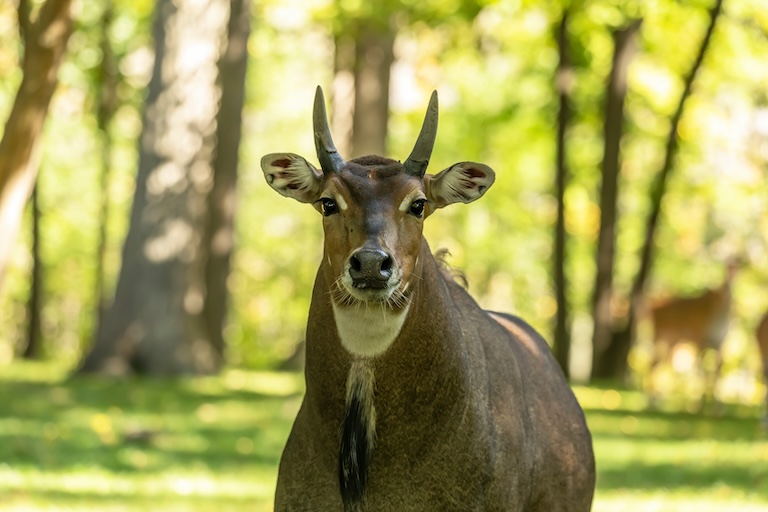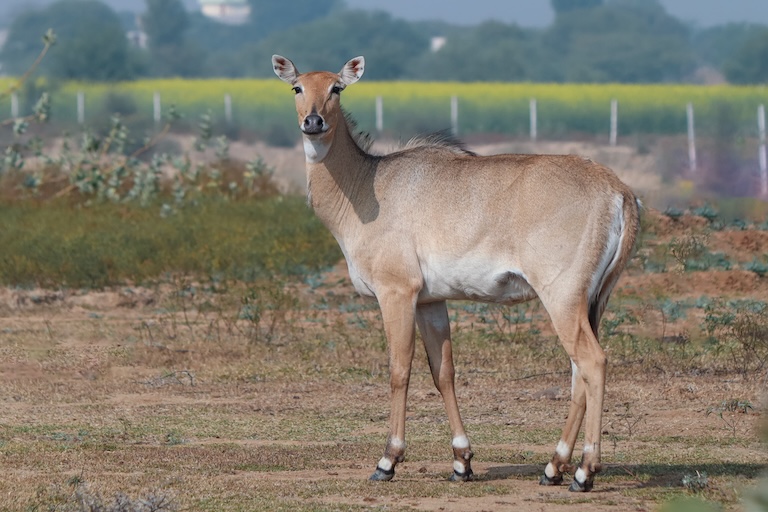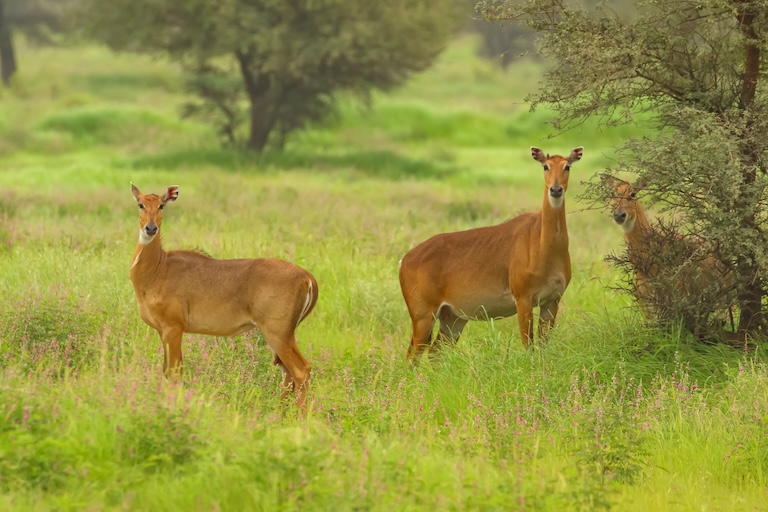Nilgai Profile
In India, there’s an animal that appears to exist outside of all reason. It’s part cow, part goat, with some camel and deer thrown in, and even perhaps a bit of donkey. Oh, and it’s blue.
And despite being a holy animal, it threatens the development of farmland in certain places and must be killed.
Very little about the Nilgai makes sense, but it appears to be working since there are more than 100,000 of them in the wild.

Nilgai Facts Overview
| Habitat: | Scrub forests, grassy plains, agricultural land |
| Location: | India |
| Lifespan: | Around 10 years |
| Size: | Up to 1.5 m (4 ft 11 in) tall, 2.1m (6ft 11 in) long |
| Weight: | Up to 288 kg (635 lb) |
| Colour: | Females are tawny orange, males blue-grey |
| Diet: | Grasses, herbs, woody plants |
| Predators: | Tigers, lions, leopards, wolves, striped hyenas |
| Top Speed: | Unknown |
| No. of Species: | 1 |
| Conservation Status: | Least Concern (IUCN) |
The Nilgai is a bit of everything. The small head on its huge body is the first sign of trouble, but the confusion goes deeper, challenging some of the most sacred belief systems of the nation.
These bizarre antelopes are enormous, but rather friendly animals, and resilient to the point that they can comfortably set up and maintain a healthy diaspora population in Texas.
Interesting Nilgai Facts
1. They’re Blue Cow-deer goat-camels
The name “nilgai” translates to “Blue cow”, which is fine. It sort of makes sense. While the females of this species are regular antelope colour, males do have a characteristic blue-grey fur, and they are bovids, so this is a reasonable moniker.
But the genus name, Boselaphus, translates to cow-deer, and this alone isn’t too far off either. Nilgai are very strange-looking and distinctive animals, with slender, deer-like heads stuck clumsily onto huge muscular bodies.
But the species name adds a layer of complexity to the scheme: tragocamelus means goat camel.
Even the common name has a bit of obscurity around it, as some refer to the blue cow as “ghodggadaha”, which means donkey. 1

2. They’re big
While its name represents a Hollywood-style rehashing of old ideas in the absence of original thought, the Nilgai’s size is undeniable. This is the largest antelope in the whole of Asia, and despite its tiny head, the beast stands 1.5m at the shoulder.
It can be over two metres long and the maximum recorded weight for one of these was 308 kg. As with most antelope, males are much larger than females, who max out at just over 200kg.
Everything but the head and legs seems disproportionately large, or maybe it’s the other way around. Nilgai have thick necks, deep, muscular bodies, and spindly little moose legs beneath them.
Perhaps the least strange thing about this antelope is the lack of rings around its horns. This is unusual – possibly unique – compared with any normal-looking antelope, but is a bit of an afterthought for this one.
3. They’re pretty chilled
While they are enormous and weird, these antelope are well known for being very laid back. They tolerate the presence of people well and can be easily tamed.
They also aren’t all that worried about moving to the city and can be seen foraging on the side of the road in various urban centres in Northern India.
The main driver of aggression in this species, as is common among mammals, is sex. 2
4. They’re tough
When competing for females, males engage in two types of fighting. Head butting, in which two males will employ the use of their – frankly, rather stumpy – horns, or neck fighting, which makes use of a far greater weapon that isn’t associated with their weird little heads.
Neck fighting is quite uncommon in ungulates, and really only something giraffes are known for, but the young Nilgai are quite good at it. It appears to be a form of mock fighting, or practice when they do, and while vigorous, rarely results in any harm being done.
Horn fighting is often far more severe. While stumpy, the horns are sharp, and many adult males have deep scarring from the fights they’ve survived. Others do not survive, as these bouts can get brutal and end in death.
5. They’re browsers and grazers
But when it’s not the time to be chasing tail, these bovids are doing a great job of eating.
Nilgais are generalist herbivores, meaning they can eat a wide range of plant-based food from the ground or shrubs and trees. While many herbivores specialise in grazing or browsing, these guys can do either or both, and this compounds how tough they are with a dimension of adaptability.
Unfortunately for farmers, this has led to some conflict. 3

6. They’re a holy pest
As fickle beings, our strongly held beliefs are often only vehemently professed while they don’t interfere with our day-to-day lives, and in India, the choice between a long-standing cow-protection movement and the continuation of industrial farming is a test of this.
Cow protection and worship has a long history across many Indian religions, but in recent years the Nilgai is testing the country’s commitment to the premise as it ravages crop fields and is becoming an agricultural pest.
While legally protected in India, some provinces have allowed for selective culling, and the controversy around this was further ignited when a video emerged of an animal being buried alive by farmers. 4
7. They live ok in Texas
This species was brought over to Texas in the 1920s to amuse zoo visitors with its unusual appearance, but being a crafty blue cow goat camel, it either escaped or persuaded someone to let it out.
There are now around 50,000 of them in Texas, which, luckily, is quite a big place, and their presence has had a surprising impact on the economy.
Being a huge and tasty bovid, people who love to kill exotic animals to feel better about themselves spend a lot of money doing so. And together with those who prefer to hunt their own meat, they’re contributing to a new industry of Nilgai hunting in the state.
Wildlife management, transportation, lodging, hospitality, retail and other satellite industries have emerged around the Nilgai in Texas as a result.
Nilgai Fact-File Summary
Scientific Classification
| Kingdom: | Animalia |
| Phylum: | Chordata |
| Class: | Mammalia |
| Order: | Artiodactyla |
| Family: | Bovidae |
| Genus: | Boselaphus |
| Species: | B. tragocamelus |
Fact Sources & References
- “Nilgai”, United Parks & Resorts.
- Wild Films India (2019), “Female nilgai goes to the city with her two young calves”, Youtube.
- “Nilgain At Knowaley Safari”, Knowsley Safari.
- Express News Service (2019), “Nilgai buried alive in Bihar, one booked”, Indian Express.
